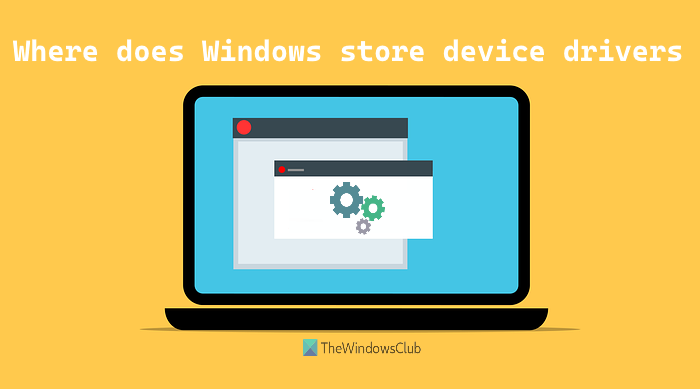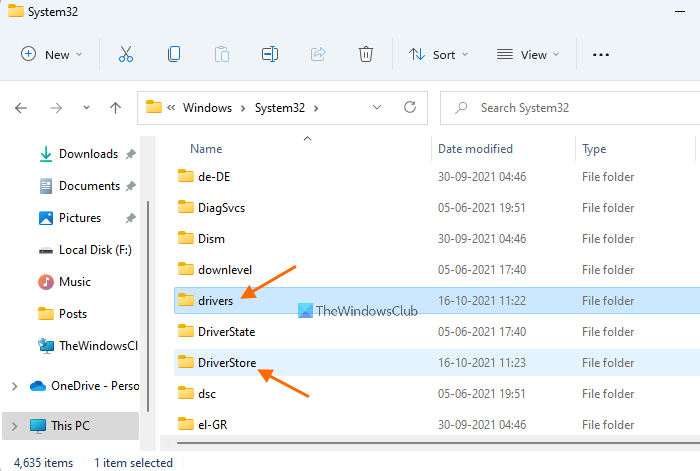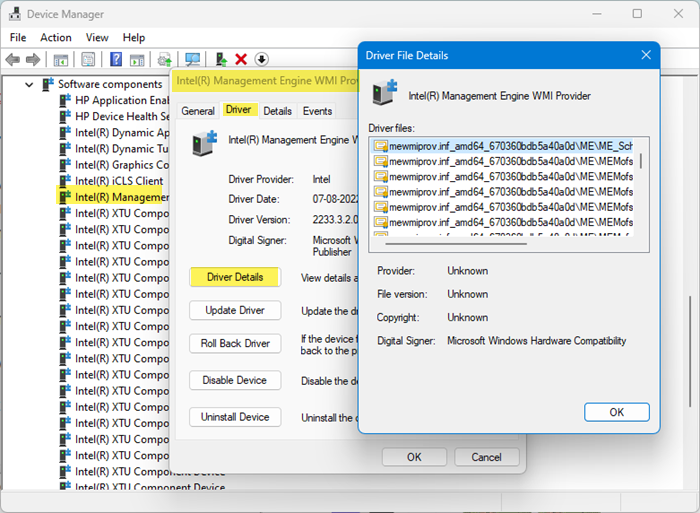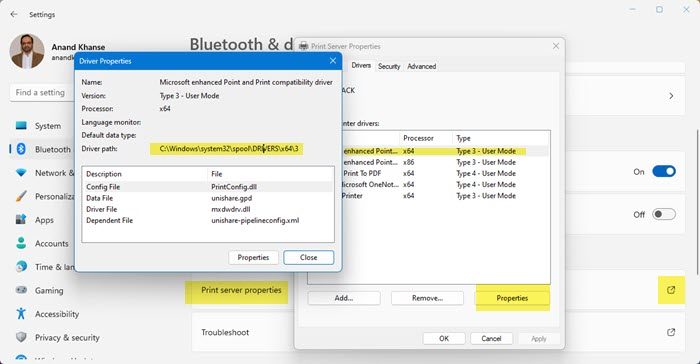You might have wondered where Drivers are stored in Windows 11/10. In this article, we will talk about the Driver folder location. The path to the folders that store device drivers remains the same in Windows 11 or Windows 10.
Device Driver Location in Windows 11/10

All of us use different types of peripherals with our computers. A hardware device that we connect to a computer externally is called a peripheral, like a keyboard, mouse, printer, etc. When you connect a peripheral to your computer for the first time, Windows takes some time to install the drivers compatible with that device.
What is a device driver?
A Device driver (or driver) is software that helps an operating system communicate with connected devices. In other words, device drivers are a set of files that are needed to operate or control hardware devices. Without a device driver, Windows OS is unable to recognize the type of device connected to it, and then you won’t be able to use that particular device. This is the reason why sometimes external devices do not work due to corrupt, wrong, or missing drivers.
Windows stores all built-in system as well as third-party device drivers in the DriverStore/FileRepository, \spool\DRIVERS\ as well as the drivers folders inside the Windows > System32 folder.

Driver folder location in Windows
When Windows detects new devices, it finds and installs the compatible drivers for those devices. It locates existing drivers from its Store and uses them. If new drivers are installed, it stores their data in one of these two folders. You can access these folders using the following path:
- C:\Windows\System32\drivers
- C:\Windows\System32\DriverStore\FileRepository
- C:\Windows\system32\spool\DRIVERS
While the drivers folder contains SYS (*.sys) files of installed drivers, the DriverStore folder includes a FileRepository sub-folder that contains INF (*.inf) files of those drivers.
- SYS files: SYS are system files of drivers required by Windows OS and these are commonly used to store drivers.
- INF files: On the other hand, an INF file is a text file that contains all the information that is required by Windows to install a device driver. This information file includes the name and the location of a particular driver, the version number of the driver, registry information, etc. That’s why the INF file is crucial for device installation. After opening the FileRepository folder, you will see the list of all drivers (in separate folders) installed on your system. The driver files that this folder contains are in INF format.
Before installing a driver, Windows copies the driver package to the DriverStore folder. This package contains the INF files and other files referred by the INF files. Some users download the device drivers from any website or untrusted sources. Downloading the drivers from untrusted sites can be a security threat because such files may contain a virus or malware. Hence, to protect users’ computers from such attacks, Windows verifies the integrity of the driver package by verifying the digital signatures before copying the driver package to the DriverStore folder.
TIP:
- Find out where to download drivers for Windows.
- How to install Drivers in Windows 11
So, now you know where Windows stores device drivers, you can simply access that path and then manually copy driver folders to backup or export them. If you want, you can also use PowerShell to export and backup device drivers.
Apart from that, you can also take the help of the DISM tool to export drivers or backup them using other ways.
Where do I find device drivers?
Windows stores device drivers physically on your hard drive. You will find all your third-party drivers in the DriverStore folder in the INF file format. We have also covered above in this post how you can open the DeviceStore folder.
Read: How to manually install a Driver using a .INF File.
How to view details of the installed Driver files?

To find out what files are used for a specific driver, take the following steps:
- Press Win+X and select Device Manager
- Find the hardware device whose details you want
- Right-click it and select Properties
- Click the Driver tab in the Device Properties box which opens
- Next, click Driver Details button
- In the next box that opens, you can check the files related to that device driver along with the full file path.
Where are printer drivers in Windows?

Printer drivers in Windows 11/10 can be found by opening Settings > Bluetooth & devices > Printers & scanners. Scroll down to Related Settings and click on Print server properties. Next, go to the Drivers tab to check if your printer is listed. Select the driver and then click on Properties. In the Driver Properties box that open, you will see its installation path as well as other details.
Why do devices need device drivers?
A driver is a connecting link between the Windows operating system and the external devices. Drivers help the Windows OS know which device is connected. If a driver is not installed correctly or gets corrupted, you will not be able to use that device.
Read: How to get a list of all Device Drivers?
Where is the Driver tab in Device Manager?
The Driver tab in the Device Manager is helpful to update, rollback, disable and uninstall a device driver. You can use the following steps to open the Driver tab for a particular device:
- Press Win+R keys to launch the Run command box
- Type devmgmt.msc in the text field
- Press the OK button. This will launch the Device Manager
- In the Device Manager, select the driver which you want to update, uninstall, or rollback
- Right-click on the selected driver
- Select Properties option.
- In the Properties window, switch to the Driver tab.
Can you Backup and Restore Drivers in Windows?
Yes, you can Backup and Restore Drivers in Windows 11/10. You can also use PowerShell, DISM, or the built-in Device Manager to manage, backup, and restore your Device Drivers. Another easy way is to use freeware like Driver Fusion, Free Driver Backup, etc., that help you easily backup and restore drivers.

INF files are an essential component within the ecosystem of WindowsThey are used to install drivers, define system settings, and automate software installation processes. Despite their importance, many users are unaware of their existence until they encounter an installation problem.
In this article, we’ll explain in detail what an INF file is, its function within the operating system, how to create and edit them, and the precautions you should take when using them to avoid security issues.
What is an INF file?
Un INF file (Information File) is a text file with the .inf extension that contains essential instructions for installing drivers and software on Windows. This type of file is interpreted by the operating system to copy files, perform system registrations and configure devices correctly.
INF files are commonly used for installation of drivers de hardware, such as printers, graphics cards, sound cards, and other external devices. They are also used in software configuration and OS without requiring user intervention. Additionally, if you’re looking for more information on file management in the system, you can read about How to recover deleted files in Windows 11.
Structure of an INF File
An INF file is composed of several sections that organize the information needed to install a driver or configure software. The most common sections include:
- Version: Specifies the file signature and the operating system version it is compatible with.
- DestinationDirs: Defines the folders to which the files will be copied.
- DefaultInstall: Contains the main instructions for installation.
- DefaultInstall.Services: Handles the installation of driver-related services.
- ServiceInstall: Adds registry entries so that the system recognizes the driver service.
- Strings: Stores reusable text variables throughout the file.
Where are INF files located in Windows?
INF files are located in various system folders. Some common directories where they can be found are:
- C:\Windows\inf: Contains the INF files used for device installation.
- C:\Windows\System32\DriverStore\FileRepository: Saves drivers along with their corresponding INF files.
- Installation folder of a downloaded driver: When you download a driver from the manufacturer’s website, it usually includes an INF file.
If you need to share or manage files in the cloud, it’s helpful to know how to share files on OneDrive, a valuable resource in the digital age.
How to install a driver with an INF file
There are several ways to install a driver from an INF file in Windows. One of the easiest methods is to perform a manual installation using the Device administrator.
Steps to install a driver with an INF file
- Download the driver along with its INF file from a trusted source.
- Open the Device administrator in Windows.
- Locate the device that needs the driver, right click and select Update Driver.
- Select the option Search your computer for driver software.
- Choosing Choose from a list of drivers on your computer and then click Use disk.
- Navigate to the driver INF file and select it.
- Follow the on-screen instructions until the installation is complete.
How to create and edit an INF file
INF files are plain text files, so they can be created and edited with any text editor such as Windows Notepad or Notepad++. When creating or editing, it’s essential to understand their structure to ensure proper functionality.
Basic INF file example
A simple INF file might look like this:
[Version] Signature = "$WINDOWS NT$" Class = SampleClass Provider = "Manufacturer Name" [DefaultInstall] CopyFiles = SampleFiles [DestinationDirs] SampleFiles = 12 [SampleFiles] filename.dll
Precautions and risks of INF files
Since INF files can contain commands auto-run, can pose a security risk if they come from unknown sources. Some tips to avoid problems include:
- Check the source of the INF file: Only download drivers from official sites or from the manufacturer.
- Scan the files with an antivirus: Some INF files may be infected with malware.
- Do not open or edit INF files without knowledge: Modifying these files without understanding their structure may affect the operating system.
Also, always make sure your operating system is free of malicious ads, which could compromise the installation of other drivers.
INF files are fundamental to the Windows ecosystem for installing and configuring hardware and software. Knowing their structure and how to use them correctly can facilitate troubleshooting and improve your system experience. However, it’s always advisable to handle these files with caution and ensure they come from reliable sources before using them.

Related article:
How to delete temporary files in Windows 11
Passionate writer about the world of bytes and technology in general. I love sharing my knowledge through writing, and that’s what I’ll do on this blog, show you all the most interesting things about gadgets, software, hardware, tech trends, and more. My goal is to help you navigate the digital world in a simple and entertaining way.
File Extension Database
Information about how to open DEVICE/INFORMATION file is not yet available in our database. Here is some information which will get you started.
To see if you have an application which can open DEVICE/INFORMATION file you need to double click on the file. This will either open it with matching application or Windows will suggest you to look for an application for file extension DEVICE/INFORMATION either on web or on local computer. If there is no application on your computer which can open DEVICE/INFORMATION file you need to search on the internet which application can open DEVICE/INFORMATION files.
File extensions help computers locate correct application for specific files. Operating systems will not look into the content of the files to be opened, but instead, it will immediate locate the file extension of the file and locate for associated application that can render the files. This helps the computer to organize its functions and work much faster. Most operating systems (Windows) require the use of file extensions, but others do not (Unix).
These file extensions are also beneficial for us. By simply looking at the filename, we can determine what type of information is stored to that and what applications can open these files. Have you noticed that when your computer acquires an unknown file, it will ask your permission to look for associated program to open it or look for these programs over the Internet? Yes! These file extensions make the work of the computer easy. Once there is no application associated with the file, then the computer will immediately ask the users assistance to help look for the source files.
If you know which application opens file extension DEVICE/INFORMATION and it is not mentioned on our site please e-mail us via contact form.
For more information about opening DEVICE/INFORMATION files read other articles on this website.
How Can I Open DEVICE/INFORMATION File on Windows
- We researched and learned that the best way to open DEVICE/INFORMATION file is to find a DEVICE/INFORMATION file in question in Windows OS File Explorer and double click on it to launch the corresponding application.
- If a DEVICE/INFORMATION file is not opened in an application and you instead get a «Windows can’t open a file» error message you should try looking for an application which can open the file in question.
- If you know the application which can open DEVICE/INFORMATION file then run it and see if there is a File->Open main menu option in the application.
- If you don’t know the application which function as DEVICE/INFORMATION file opener then try to search online for «DEVICE/INFORMATION viewer», «application to open DEVICE/INFORMATION file» or «open DEVICE/INFORMATION file» queries in the search engine you like.
- Install the application you found and check if it can open DEVICE/INFORMATION file
How Can I Open DEVICE/INFORMATION File on Mac OS
- We recommend to find a DEVICE/INFORMATION file in question in Mac OS Finder and double click on it to launch the corresponding application.
- If a DEVICE/INFORMATION file is not opened in a Mac OS application and you instead get a «There is no application set to open the file» error message you can click on «Search App Store» in the error dialog and Mac OS will show you applications compatible with DEVICE/INFORMATION file.
- If you know the Mac OS application which can work as DEVICE/INFORMATION file opener you can choose the «Choose Application…» option in the error box to associate the file extension and open DEVICE/INFORMATION file in it.
- If you don’t know the application which can open DEVICE/INFORMATION file then try to search for «DEVICE/INFORMATION viewer», «application to open DEVICE/INFORMATION file» or «read DEVICE/INFORMATION file» queries in the online search engine you like.
- Install the application you found and check if it can read DEVICE/INFORMATION file
How Can I Open DEVICE/INFORMATION File on Android
If you downloaded a DEVICE/INFORMATION file on Android device you can open it by following steps below:
- In the Android apps list on your Android device find «My Files» or «File manager» app and tap to start it.
- Tap on «Downloads» folder inside the app.
- You should see your downloaded DEVICE/INFORMATION file in that folder.
- Tap on the file. If Android device supports opening the file you downloaded it will open in the corresponding app.
- If file does not open you can look for the corresponding app that can open the file by searching Android App Store for the «DEVICE/INFORMATION».
- If you cannot open the file with the apps from Android App Store it is possible that the file could only be opened on desktop platforms such as Windows or Mac OS. Try searching for «DEVICE/INFORMATION viewer», «DEVICE/INFORMATION file reader» online and see if any desktop applications can open it.
- It is also possible that the file you downloaded is outdated and is no longer supported.
How to Open DEVICE/INFORMATION File on iPhone or iPad
To open DEVICE/INFORMATION File on iOS device follow steps below:
- We advies to open Files app on your iPhone or iPad device. You can find it by swiping down on the home screen and typing «Files» in the search bar.
- Tap on the Downloads folder on the Files app home screen.
- You will see all files that you recently downloaded. Tap on the DEVICE/INFORMATION file to view it.
- If you have the right app that can open it it will automatically launch and open your file.
- If you don’t have the app which can open it you need to serch Apple app store for «DEVICE/INFORMATION». This way you can find apps which can open DEVICE/INFORMATION files.
- If this doesn’t help it is possible that your file could be opened only by the desktop application. To find an app which can open it on desktop look for «DEVICE/INFORMATION viewer» or «DEVICE/INFORMATION file» online in your favorite search engine.
Populating this website with information and maintaining it is an ongoing process. We always welcome feedback and questions that can be submitted by visiting Contact Us page. However since there are many users visiting this website and because our team is quite small we may not be able to follow up personally on every request. Thank you for your understanding.
DEVICE/INFORMATION file article translations
From Wikipedia, the free encyclopedia
Setup Information file
| Filename extension |
.inf |
|---|---|
| Internet media type |
text/plain |
| Type of format | Configuration file |
Precompiled Setup Information file
| Filename extension |
.pnf |
|---|---|
| Internet media type |
application/octet-stream |
| Type of format | Configuration file |
An INF file (setup Information file) is an INI plain-text file used by Microsoft Windows-based operating systems for the installation of software and drivers.[1] INF files are most commonly used for installing device drivers for hardware components.[2] Windows includes the IExpress tool for the creation of INF-based installations. INF files form part of the Windows Setup API and of its successor, Windows Installer.
The \windows\inf directory contains several such .inf files.[3]
Precompiled setup Information file (*.pnf) is a binary representation of an INF file compiled by the operating system.
The structure of an INF file is very similar to that of an INI file; it contains various sections that specify the files to be copied, changes to the registry, etc. All INF files contain a [Version] section with a Signature key–value pair specifying the version of Windows that the INF file is meant for. The signature is commonly $CHICAGO$ (for Windows 9x) or $WINDOWS NT$ (for Windows NT/2K/XP). Most of the remaining sections are user-defined and contain information specific to the component being installed.
An example of an INF file might have something like this:
[autorun] open=example.exe
What this would do is open the example.exe file automatically whenever the media containing the file (in its root directory) is connected to the computer. This can be dangerous, as there is no way to tell whether such a file exists before inserting the media. Since Windows XP, however, this feature has been replaced with a menu forcing the user to choose which action to take.
INF Files can sometimes be dangerous on Windows 2000 as they may allow viruses to autorun without prompting.[citation needed]
They are blocked on Windows 7, but can be worked around. [4]
[autorun] open=example.bat icon=cd.ico
icon=*.ico command replaces any old or default drive icon with the specified one.
[autorun] can be replaced by [AutoRun] or [Autorun].
The INF file may specify values for Windows Registry entries. Drivers providers and users may for instance use this feature to override display Extended Display Identification Data (EDID) metadata for displays that have corrupted ROM memory.[5]
- Autorun.inf
- Cabextract
- ^ tedhudek. «Overview of INF Files — Windows drivers». learn.microsoft.com. Retrieved 2022-11-29.
- ^ lorihollasch. «Creating an INF file for a file system driver — Windows drivers». learn.microsoft.com. Retrieved 2022-11-29.
- ^
Norton, Peter; Mueller, John Paul (28 October 1997). Peter Norton’s Complete Guide to Windows XP. Pearson Education (published 1997). ISBN 9780132715386. Retrieved 2014-08-31.Look in the \WINDOWS\INF directory, and you’ll see a set of INF files.
- ^ «How To Auto-Launch Apps With A USB Stick [Windows]». 22 September 2011.
- ^ lorihollasch. «Manufacturer override of monitor EDIDs — Windows drivers». learn.microsoft.com. Retrieved 2022-11-29.
- INF Files at MSDN
- Internet Component Download with INF Files at MSDN
- Standard Modem Command Sets and INFs.
More information about INF file
INF file format is used by so-called information files, in plain text format, and used in Windows systems for software, drivers, or update installation processes. INF file stores structured data related to files that should be copied, information about driver version, register entries to be added or modified, and various other information, such as creation date, version number, or author.
INF file data is stored in plain text format; INF file are used by device and Windows software installers. Data stored in INF file typically describes folder and installer files location.
Location of INF files
INF files are commonly included in installers and installation packages for Windows applications. INF file are also included in software update packages, and such INF file store default settings, device configs, and logs.
One of the most known INF file is Autorun.inf file stored on mass storage devices which defines which programs should be run after mounting the device. Windows systems older than Vista did not monitor such devices for viruses and therefore such INF files could be used as a malware infection vectors.
INF file structure
Structure of INF file is resembles closely that of INI file since both formats define actions divided into sections. Each INF features a [Version] section that contains Signature describing Windows version for which the INF file is dedicated. Other sections are mainly user-defined and store information related to defined components.
How to open INF files
If you cannot open the INF file on your computer — there may be several reasons. The first and most important reason (the most common) is the lack of a suitable software that supports INF among those that are installed on your device.
A very simple way to solve this problem is to find and download the appropriate application. The first part of the task has already been done – the software supporting the INF file can be found in the table. Now just download and install the appropriate application.
Possible problems with the INF format files
The inability to open and operate the INF file does not necessarily mean that you do not have an appropriate software installed on your computer. There may be other problems that also block our ability to operate the Windows Installation Script Format file. Below is a list of possible problems.
- Corruption of a INF file which is being opened
- Incorrect links to the INF file in registry entries.
- Accidental deletion of the description of the INF from the Windows registry
- Incomplete installation of an application that supports the INF format
- The INF file which is being opened is infected with an undesirable malware.
- The computer does not have enough hardware resources to cope with the opening of the INF file.
- Drivers of equipment used by the computer to open a INF file are out of date.
If you are sure that all of these reasons do not exist in your case (or have already been eliminated), the INF file should operate with your programs without any problem. If the problem with the INF file has not been solved, it may be due to the fact that in this case there is also another rare problem with the INF file. In this case, the only you can do is to ask for assistance of a professional staff.
